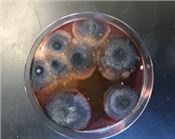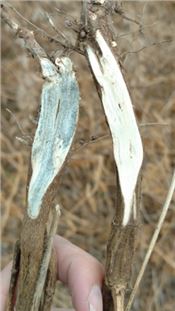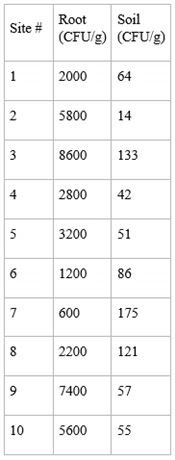Charcoal Rot: What Is It And How To Screen For It
RACHEL GUYER
JACKSON, TENN.
The fungus Macrophomina phaseolina is a soil-borne pathogen that infects nearly 500 species of plants including soybean, cotton, and corn and causes the disease charcoal rot. What does this mean for West Tennessee farmers? Soil and debris from infected fields can harbor microsclerotia – tiny spherical overwintering structures produced by the fungus (Image 1) – and be a source of inoculum from one season to the next, even from one crop to another depending upon your rotation. So, it can be a double whammy for those practicing no-till in a soybean-corn rotation. Harkening back to the traditional plant disease pyramid, four components must be present in order for disease to affect yield:
• Pathogen
• Environmental conditions favorable to pathogen production
• Susceptible host
• Timing of host-pathogen interaction during the growing season
‘PEST’ is an easy acronym to remember these crucial components because if even one is missing disease will not threaten yield.
Screening is therefore essential in order to know if a pathogen is present in your field so that you can know when it is necessary to incorporate management options into your integrated pest management (IPM) field practices. See p.8 of our Soybean Disease and Nematode Identification Field Guide here for symptoms and management options for this disease.
Right now we are in the midst of a large-scale screening project for charcoal rot and soybean cyst nematode across West Tennessee. But how do we actually screen the soil and root samples we receive from fields for charcoal rot? A careful process of collecting, grinding, sterilizing, and plating samples on nutrient-rich media yield the amount of charcoal rot in CFUs (Image 2), or colony-forming units, that are quantified per gram of soil or root.
This allows us to extrapolate the CFUs from each sample to eventually estimate the potential yield loss for a given population of charcoal rot present in a field. In 2017, paired soil and root samples from 10 sites were screened for Macrophomina phaseolina from Gibson and Madison counties (Image 3).
While all sites were positive, amounts of charcoal rot varied not only by location but also between root and soil samples, which can be expected. Returning to the plant disease pyramid, differences in susceptible hosts (crop varieties) and environmental conditions (e.g. soil textures) will affect the potential for a disease to affect yield.
We are still collecting soil samples for this project through the end of the year. For more information, see previous article Free Soil Testing for Pathogens or contact your local county agent or Heather Kelly, Plant Pathologist (UT), by email (youngkelly@utk.edu) or phone (731-425-4713). Send soil samples to: Plant Pathology Lab C, WTREC, 605 Airways Blvd, Jackson, TN 38301. ∆
RACHEL GUYER: Plant Pathology Research Associate, University of Tennessee

Image 2. CFUs (colony-forming units) of Macrophomina phaseolina grown on nutrient-rich media.

Image 1. Cut soybean stems. The right is healthy while the left is covered in microsclerotia,
the overwintering structure produced by Macrophomina phaseolina.

Image 3. CFUs of Macrophomina phaseolina from soil and soybean
root tissue from 10 sampled sites in 2017.